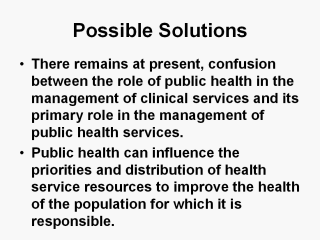| front |1 |2 |3 |4 |5 |6 |7 |8 |9 |10 |11 |12 |13 |14 |15 |16 |17 |18 |19 |20 |21 |22 |23 |24 |25 |26 |27 |review |
 |
The skills and concerns of
public health are agreed. But there remains at present, confusion between
its role in the management of clinical services and its primary role in the
management of public health services. Its present service structure is as part of the corporate team that contracts both public health and clinical services from National Health Service providers for a defined population in a defined geographical area. Public health can thus influence the priorities and distribution of health service resources to improve the health of the population for which it is responsible. However, as the health authorities are appointed by the Secretary of State for Health, they have no powers to influence the policies or activities of other departments with responsibilities which impact on health and disease, such as housing, environment, social services or education, which are controlled by locally elected representatives of local councils and their officials. The only way these can be influenced, at local level, is by formal and informal consultative mechanisms or partnership arrangements. Although theoretically, some transfers of resources between the two types of authority are feasible, they only occur rarely, and the amounts transferred are usually relatively very small. At central government level, the Chief Medical Officer of the Department of Health is also the Chief Medical Officer to other Departments of State - Education, Home Office, Social Services, Environment. In addition there are formal (and informal) inter Departmental committees, including at Cabinet level, to try to develop relevant central governmental policies, for example in support of the Health of the Nation targets and program. But it is at this level that the problem for the public health is particularly stark. Although Chief Medical Officers, since the first incumbent John Simon, have been willing to enunciate publicly about health hazards such as inadequate housing or the dangers of cigarette smoking, both their public pronouncements and actions have been circumscribed by their political masters. Recent Chief Medical Officers have had their powers reduced, their resources cut, and their ability to influence policies further constrained. The difficulties for public health to influence policies or events are even greater at lower levels. We have already referred to the constraints on the annual reports produced by Directors of Public Health and the possibility of influencing resource allocation policies outside the health sector, at local level, is very restricted or non existent. |